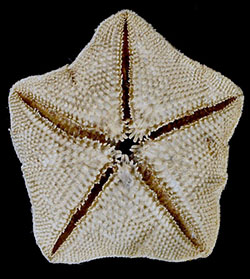 Deciphering evidence for sea star evolution has long intrigued biologists. To explore speciation between two similar-looking sea stars, Jonathan Puritz (pictured below) of the Institute of Marine Biology at The University of Hawaii coordinated a research team to correlate the genetic and geographic differences between two Coral Sea species.
Deciphering evidence for sea star evolution has long intrigued biologists. To explore speciation between two similar-looking sea stars, Jonathan Puritz (pictured below) of the Institute of Marine Biology at The University of Hawaii coordinated a research team to correlate the genetic and geographic differences between two Coral Sea species.
The team’s report, entitled “Extraordinarily rapid life-history divergence between Cryptasterina sea star species,” was published last week in the Proceedings of the Royal Society.
Since these sister species, Cryptasterina pentagona (pictured left), and Cryptasterina hystera, have recently been re-classified as two distinct species, the purpose of the study was to investigate the genetic mechanisms driving the sea star evolution of these sisters – a microcosm of evolution.
In The Origin of Species, Charles Darwin argued that all species evolve incrementally from a common ancestor through a process of “natural selection” –
“On the theory of natural selection, we can clearly understand why she should not, for natural selection acts only by taking advantage of slight successive variations; she can never take a great and sudden leap, but must advance by the short and sure, though slow steps.”
Although these two echinoderms appear nearly identical and live in adjacent geographical ranges, one lays eggs the other delivers via live birth. For this reason, the team argued that this speciation event –
“… may represent the minimal level of modification.”
By examining this miniaturized model, the goal of the team was to gain insight into the incremental molecular mechanisms involved in speciation on this scale, which might demonstrate a yet unknown natural law of evolution on a broader scale.
Sea Star Study Results
On the molecular level, the results invalidated their expectations. Rather than finding evidence of incremental genetic variations,” the team observed distinct differences, no gradual changes.
“A striking difference in levels of genetic diversity between species.”
The team also unexpectedly observed an “extremely” low correlation between genetic differences and geographic distribution –
“This lack of correlation between geographical and genetic distance at any scale suggests that gene flow is extremely limited among all populations.”
The expectations of the team to find Darwin’s incremental changes on this small scale were unrealized.
Sea Star Evolution Implications
 “It’s as dramatic a difference in life history as in any group of organisms,” said Rick Grasberg (pictured left), professor of evolution and ecology at UC Davis and coauthor, according to ScienceDaily. Dramatic differences, rather than incremental changes in life history, undermine Darwin’s theory of natural selection. Darwin’s dilemma intensifies.
“It’s as dramatic a difference in life history as in any group of organisms,” said Rick Grasberg (pictured left), professor of evolution and ecology at UC Davis and coauthor, according to ScienceDaily. Dramatic differences, rather than incremental changes in life history, undermine Darwin’s theory of natural selection. Darwin’s dilemma intensifies.
In place of a “minimal level” example of natural selection through “slight successive” changes, as expected, the team conceded –
“Our results suggest that disruptive selection for different life-history phenotypes between sea stars in different habitats may be a short pathway to rapid evolutionary divergence and speciation.”
The implications on this scale undermine Darwin’s theory of natural selection on a broader scale. In place of natural selection, the team found evidence of “disruptive selection.” And, rather than evolution working through “though slow steps,” the team failed to find any. The team’s summary undermines the foundational dogmas of the evolution industry –
“Here, we use new population genetic and phylogeographic analyses to investigate an extraordinary example of both geographically localized and geologically instantaneous evolution.”
This sea star evolution study underscores why scientists are increasingly skeptical of Darwin’s theory of evolution. According to Swedish biologist Soren Lovtrup,
“Today it is still commonly claimed that Darwin’s natural selection is the evolutionary mechanism par excellence. However, this assertion is not based on any factual evidence.”
Genesis
The Coral Sea sea stars demonstrate why scientists are increasingly skeptical of the theory of evolution. The evidence, however, is comparable with the Genesis account written by Moses.
John Woodward (pictured right), an English naturalist and geologist, founded the Woodwardian Professorship of Geology at Cambridge University. Woodward was a close friend of Isaac Newton. As Woodward explains during the Scientific Revolution –
“[The geological record] vindicates, supports, and maintains the Mosaick Account of things, as exactly agreeable to the Phaenomena of Nature.”
Refer to the Glossary for the definition of terms and to Understanding Evolution to gain insights into understanding evolution.
2020 Update
Cryptasterina pentagona – while the term “evolution” does not appear in the text, the opening paragraph notes –
“The two appear to have diverged from a common ancestral line only a few thousand years ago.”
Cryptasterina hystera – while the term “evolution” does not appear in the text, the opening paragraph notes –
“The two appear to have diverged from a common ancestral line a few thousand years ago.”
Evolution 101 does not include any discussion of these sea stars.
Smithsonian National Museum of Natural History
“Showing results 1 – 0 for Cryptasterina.”
Importantly, as of August 2020, no other reports on the evolution of sea stars have been published.

